| dc.contributor.advisor | Peña Rodríguez, Alberto | |
| dc.contributor.advisor | MAGALLON BARAJAS, FRANCISCO JAVIER | |
| dc.contributor.author | OMONT, ALEXIA MORGANE | |
| dc.date.issued | 2022 | |
| dc.identifier.uri | http://dspace.cibnor.mx:8080/handle/123456789/3105 | |
| dc.description.abstract | "Los sistemas de monocultivo de camarón presentan grandes retos para continuar con su crecimiento sostenido, en parte debido a la dependencia en harina de pescado, la contaminación de las aguas costeras por las aguas residuales y los brotes de enfermedades emergentes. El desarrollo de sistemas acuícolas de integración multitrófica (IMTA, por sus siglas en inglés) representa una alternativa para el desarrollo de una acuicultura productiva y sostenible en México y el mundo. El principio radica en convertir los “desechos” de una especie que requiere ser alimentada con alimentos balanceados, en activos útiles para otras especies llamadas “filtrantes” de materia orgánica (p. ej. Crassostrea gigas) e inorgánica (p. ej. Ulva lactuca), ofreciendo mayor bioseguridad, diversificación de productos y bajo impacto ambiental. Por otro lado, el uso de ingredientes funcionales a base de macroalga como nueva fuente de proteína es una de las propuestas de la industria de alimentos acuícolas para sustituir la harina de pescado en los alimentos. Este proyecto de tesis se centró en desarrollar, optimizar y evaluar un sistema IMTA con P. vannamei, C. gigas y Ulva sp. con la finalidad de mejorar la productividad, eficientizar el uso de nutrientes y mejorar el control microbiológico, respecto a sistemas tradicionales de monocultivo. El sistema IMTA permitió una eficiencia de retención de nitrógeno y fósforo de 82% y 59.6% respectivamente, aumentando un 34% el crecimiento del camarón respecto al monocultivo y diversificando la producción con ostiones y macroalga; mientras el sistema de monocultivo de camarón retiene solamente 37% de nitrógeno y 13% de fosforo en la biomasa producida. De la biomasa generada de macroalga, se realizó una predigestión química, enzimática y biológica para producir detritos, los cuales se lograron incorporar al 20% como sustituto parcial de la harina de pescado en el alimento balanceado para camarón sin afectar el rendimiento productivo del camarón. La inclusión de este alimento en el sistema IMTA resultó en una mejora en el aprovechamiento de los nutrientes (90.3% del nitrógeno y 78% del fosforo) principalmente a favor de una mayor biomasa de macroalga. Finalmente, con el nuevo alimento y el cultivo integrado, se observó una modulación de la actividad digestiva de los organismos asociada a cambios significativos en su microbiota digestiva..." | es |
| dc.format | pdf | es |
| dc.language.iso | spa | es |
| dc.publisher | Centro de Investigaciones Biológicas del Noroeste, S.C. | es |
| dc.rights | Acceso abierto | es |
| dc.subject | Acuacultura sustentable, Detrito, Penaeus vannamei, Crassostrea gigas, Ulva lactuca | es |
| dc.subject | Sustainable aquaculture, Detritus, Penaeus vannamei, Crassostrea gigas, Ulva lactuca | es |
| dc.subject.classification | NUTRICIÓN | es |
| dc.title | DINÁMICA MICROBIANA Y FLUJO DE NUTRIENTES EN UN SISTEMA ACUÍCOLA DE INTEGRACIÓN MULTITRÓFICA: CAMARÓN, OSTIÓN Y MACROALGA | es |
| dc.type | doctoralThesis | es |
| dc.dirtesis.grado | Doctorado en Ciencias en el Uso, Manejo y Preservación de los Recursos Naturales | es |
| dc.dirtesis.disciplina | Acuicultura | es |
| dc.dirtesis.universidad | Centro de Investigaciones Biológicas del Noroeste, S.C. | es |
| dc.dirtesis.facultad | Posgrado en Recursos Naturales | es |
| dc.description.abstracten | "Shrimp monoculture systems present great challenges to continue their sustained growth, in part due to dependence on fishmeal, to pollution of coastal waters by sewage, and to outbreaks of emerging diseases. The development of integrated multitrophic aquaculture systems (IMTA) represents an alternative for the development of a productive and sustainable aquaculture in Mexico and the world. The principle lies in converting the "waste" of a species that needs to be fed with balanced food, into useful assets for other species called "filtering" of organic matter (e.g., Crassostrea gigas) and inorganic (e.g., Ulva lactuca), offering greater biosecurity, product diversification and low environmental impact. On the other hand, the use of functional ingredients based on macroalgae as a new source of protein is one of the proposals of the aquaculture industry to replace fishmeal in diets. This PhD project focused on developing, optimizing and evaluating an IMTA system with P. vannamei, C. gigas and Ulva sp. in order to improve productivity, to make the use of nutrients more efficient and to improve microbiological control, compared to traditional monoculture systems. The IMTA system allowed an efficiency of nitrogen and phosphorus retention of 82% and 59.6% respectively, increasing shrimp growth by 34% compared to monoculture and diversifying production with oysters and macroalgae; while the shrimp monoculture system retains only 37% nitrogen and 13% phosphorus in the biomass produced. From the biomass generated from macroalgae, a chemical, enzymatic and biological predigestion was carried out to produce detritus, which was able to incorporate 20% as a partial substitute for fish meal in the balanced feed for shrimp, without affecting the productive performance of the shrimp. The inclusion of this food in the IMTA system resulted in an improvement in the use of nutrients (90.3% of nitrogen and 78% of phosphorus) mainly in favour of a greater macroalgae biomass. Finally, with the new diet and the integrated culture, a modulation of the digestive activity of the organisms associated with significant changes in their digestive microbiota was observed. In terms of microbiological control, the IMTA system made it possible to reduce the relative abundance of Vibrionaceae in the digestive tract of shrimp and in the digestive gland of oysters, as well as in shrimp fed with U. lactuca detritus..." | es |

